Dr. Hannan’s journey in Bangladesh is nothing short of remarkable, showcasing the incredible potential of the Surgical Sight Program to transform lives. In a nation where access to specialized medical expertise can be challenging, Dr. Hannan’s recent success story shines brightly. With the invaluable assistance of Ohana One, he was able to train other local surgeons on a complex DSD (Disorders of Sex Development) case in a 7-month-old baby.
Providing training and mentoring on difficult cases such as these is a key step in local surgeons having the skills they need to serve their communities. This training case involved two critical conditions, hypospadias, and undescended testes, both of which require precise surgical intervention. Dr. Hannan used smart glasses while navigating this intricate surgical landscape to provide his mentees with unparalleled access to the surgery. This ability to “see what I see” during the surgery provides training his mentees would otherwise need to travel to obtain.
The event was truly immersive and interactive, attracting the attention of medical professionals and leaders in the field. Among them, Professor Mirza Kamrul Zahid, Secretary General of the Association of Pediatric Surgeons of Bangladesh (APSB), who joined the training session from DMCH. Prof Zahid, recognizing the importance of such technological advancements in advancing healthcare in his country.
Dr. Hannan has been able to share his expertise with the medical community in Bangladesh, conducting Remote Surgical/Laparoscopy Training using Smart glasses and Augmented Reality. He is able to train his mentees who work at institutions such as Dhaka Medical College Hospital (DMCH), Health & Hope Hospital, and Dhaka Pediatric, Neonatal & General Hospital without them having to travel.
Dr. Hannan’s story serves as an inspiring testament to the possibilities that emerge when cutting-edge technology and dedicated medical professionals converge to address complex healthcare challenges. His work not only transforms individual lives but also paves the way for a brighter future in healthcare for Bangladesh and beyond.


Recent Comments